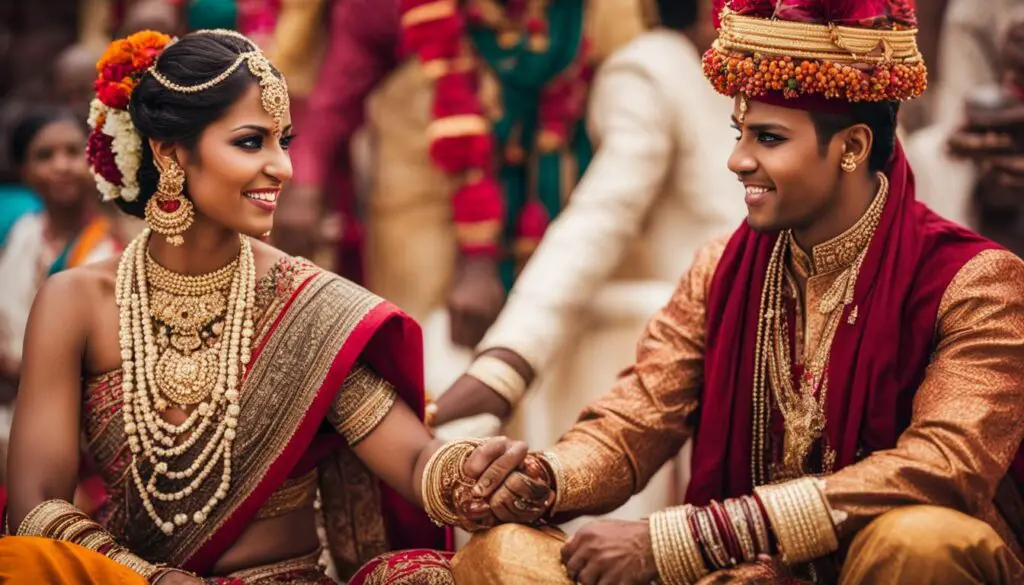
In ancient Israelite culture, marriage and courtship customs were deeply rooted in tradition and played a crucial role in the formation of familial alliances. The Bible offers valuable insights into these customs, shedding light on the practices and beliefs of the time.
Marriages in biblical times were predominantly arranged by the fathers of the bride and groom, focusing on the mutual benefit of both families rather than romantic love. Betrothal, or engagement, marked the beginning of the marriage process and was often agreed upon at a young age. The groom’s father negotiated the betrothal by paying a bride price, known as mohar, to the bride’s family.
The betrothal was considered binding, accompanied by the signing of a marriage contract called a ketubah. The groom would then return to his father’s house to prepare a bridal chamber, and upon its completion, he would joyfully fetch his bride with a trumpet call and a shout.
The wedding ceremony itself was intimate, attended by a select few, followed by a grand wedding feast to celebrate the union. These customs and practices were not only prevalent in ancient Israel but were also significant influences on the teachings of Jesus, who often drew metaphors from Jewish marriage customs to illustrate God’s relationship with the church.
By exploring the marriage and courtship customs detailed in the Bible, we gain valuable insights into the historical context in which these practices evolved and the significance they held in ancient Israelite society.
Key Takeaways:
- Marriages in ancient Israel were primarily arranged for mutual familial benefit rather than romantic love.
- Betrothal, marked by a bride price and the signing of a marriage contract, initiated the marriage process.
- Customs included the groom preparing a bridal chamber and joyfully fetching his bride with trumpet calls and shouts.
- The wedding ceremony was intimate, attended by a select few, followed by a grand feast.
- Jesus often used Jewish marriage customs as allegories to illustrate God’s relationship with the church.
Marriage and Women’s Roles in Ancient Israel
Marriage customs in ancient Israel were shaped by cultural and religious beliefs, resulting in unique practices that differed from modern notions of marriage and dating. Men in ancient Israel were allowed to have multiple wives, while women were expected to be virgins when they got married. Polygamy was not uncommon, although its prevalence is debated. The relationship between husbands and wives was often unequal, with men having more control over whom they married. The Hebrew word for husband, “ba’al,” also meant “lord” or “master,” underscoring the power dynamics within marriages.
The customs surrounding marriage in ancient Israel were also influenced by the importance placed on blood. The shedding of virginal blood was seen as sealing the covenant between husband and wife. Marriages between cousins were preferred, and intermarriage with non-Israelites was treated differently in different biblical texts. Men had the authority to exercise life-and-death power over women in cases of adultery, and they were also permitted to visit prostitutes. These practices highlight the patriarchal nature of ancient Israelite society and the limited agency afforded to women.
“The Hebrew word for husband, ‘ba’al,’ also meant ‘lord’ or ‘master,’ underscoring the power dynamics within marriages.”
It is important to view these marriage customs in the context of their historical period and cultural framework. While some aspects may seem objectionable to modern sensibilities, they reflect the social norms and values of ancient Israel. By understanding the traditional marriage practices in the Old Testament, we can gain insights into the roles and expectations placed upon individuals within ancient Israelite society.
| Marriage Customs in Ancient Israel | Key Characteristics |
|---|---|
| Polygamy | Men were allowed to have multiple wives |
| Power dynamics | Husbands had more control and authority |
| Virginity | Women were expected to be virgins when they got married |
| Bloodshed | Importance placed on shedding of virginal blood in sealing the covenant |
| Intermarriage | Different treatment of intermarriage with non-Israelites in biblical texts |
| Male authority | Men had life-and-death power over women in cases of adultery |
Biblical Perspectives on Courtship and Marriage in Ancient Israel and Other Cultures
Marriage customs in ancient Israel provide a fascinating insight into the traditions and practices of this ancient society. However, it is essential to note that other cultures and historical periods had their own unique perspectives on courtship and marriage. By exploring these different customs, we can gain a broader understanding of the diverse ways in which relationships were formed and celebrated.
In Classical Rome, for example, marriage was generally monogamous, with an emphasis on a contractual agreement rather than the exchange of a bride price. The father of the bride would pay the groom a dowry, which represented the transfer of property and assets. This contrasted with the practices in ancient Israel, where the groom’s family would negotiate a bride price with the bride’s family, often in the form of money or property.
In medieval times, the Christian church played a significant role in shaping marriage customs. The early church emphasized the sanctity of marriage and viewed it as a lifelong commitment and a holy sacrament. As a result, priests began performing wedding ceremonies, and marriage became a more formalized institution. The relationship between husbands and wives also began to shift, with greater emphasis on mutual love and respect.
The Role of Marriage in Different Cultures:
- Ancient Israel: Arranged marriages, bride price, emphasis on blood covenant
- Classical Rome: Monogamy, dowry payment, contractual agreement
- Medieval Europe: Church-sanctioned unions, emphasis on lifelong commitment and love
The diversity of marriage customs across cultures demonstrates how societal values and religious beliefs shaped the institution. These customs provide us with valuable insights into the historical context in which biblical teachings on marital relationships were developed.
As we continue to explore the customs and practices surrounding courtship and marriage in different cultures, it is important to approach these topics with a respect for cultural diversity and historical context. While some customs may seem unfamiliar or even controversial to modern sensibilities, they offer us a unique window into the lives and relationships of our ancestors. By studying these customs, we can gain a deeper appreciation for the complexities of human history and the evolution of the institution of marriage.

Conclusion
Marriage and courtship customs in the Bible provide a fascinating glimpse into the traditions and practices of ancient Israelite society. These customs were shaped by cultural, social, and religious factors that influenced the viewpoints on marital relationships.
While some aspects of biblical marriage practices may seem unfamiliar or objectionable to modern western societies, it is crucial to understand that these viewpoints evolved over time. The biblical texts themselves offer diverse perspectives on marriage, reflecting the changing attitudes and beliefs of different historical periods.
Studying these customs allows us to gain a deeper understanding of the historical context in which biblical teachings on marital relationships were developed. By examining the customs prevalent in ancient Israel and comparing them to practices in other cultures and historical periods, we can appreciate the diversity and complexity of human relationships throughout history.
Overall, the study of marriage and courtship customs in the Bible offers valuable insights into the complexity of human relationships and the ways in which societal norms and beliefs shape our understanding of marriage. By exploring these customs, we can continue to learn from the past and apply that knowledge to our present-day experiences.
FAQ
Were marriages arranged in ancient Israel?
Yes, marriages in ancient Israel were primarily arranged by the fathers of the bride and groom for the mutual benefit of both families.
What was the process of betrothal?
Betrothal, or engagement, was the first step in the marriage process. It was often agreed upon at a young age and considered binding. A marriage contract, called a ketubah, was often signed.
How were marriages sealed in ancient Israel?
The marriage contract and the shedding of virginal blood sealed the covenant in ancient Israelite marriages.
Did men have more than one wife in ancient Israel?
Yes, men in ancient Israel were allowed to have multiple wives, while women were expected to be virgins when they got married. Polygamy was not uncommon.
What was the role of women in ancient Israelite marriages?
Women in ancient Israelite marriages had less control over whom they married, and the relationship between husbands and wives was often unequal. The Hebrew word for husband, “ba’al,” also meant “lord” or “master.”
Were marriages between cousins preferred in ancient Israel?
Yes, marriages between cousins were preferred in ancient Israelite culture.
How did marriage customs in ancient Israel differ from other cultures?
Marriage customs in ancient Israel, such as polygamy and the concept of blood sealing the covenant, differed from other cultures. For example, in Classical Roman society, marriages were generally monogamous, and a dowry was paid by the father to the groom.
Did biblical teachings on marriage evolve over time?
Yes, biblical teachings on marriage evolved over time, and the texts offer diverse viewpoints influenced by cultural, social, and religious factors.








